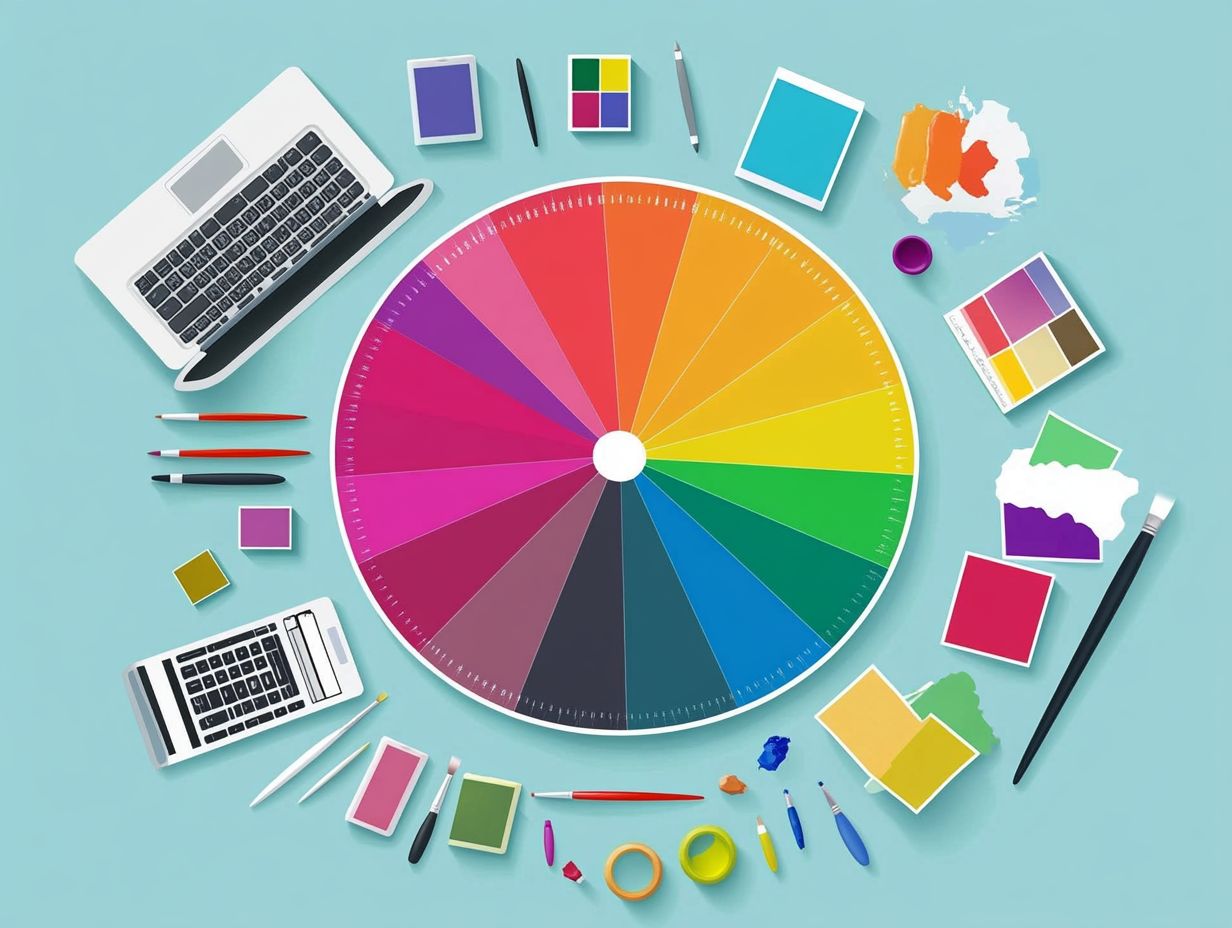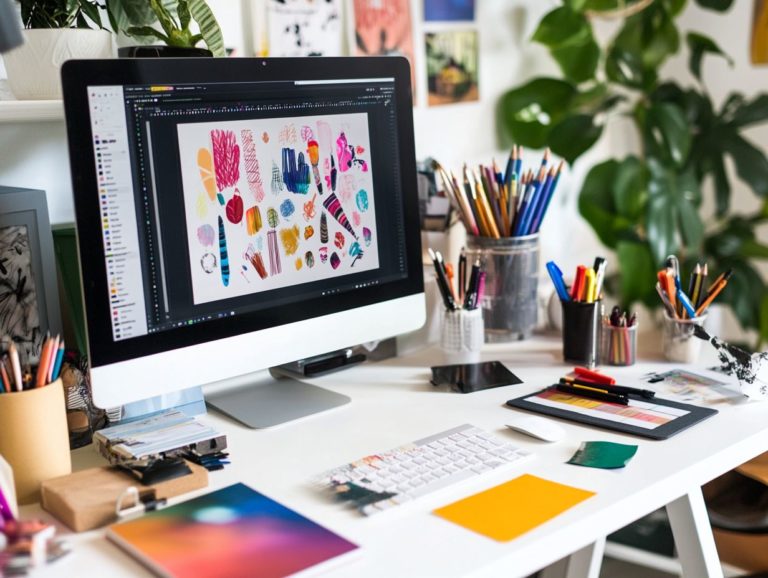Mastering Color Theory: Online Resources to Explore
Color theory is crucial in design. It influences how you see and interact with visuals.
This exploration covers the basics of color theory and how it applies to your design projects. You’ll also learn about the psychology behind your color choices.
Discover valuable online resources, practical tools for experimentation, and expert tips to sharpen your skills.
Whether you re new to design or have some experience, mastering color theory can take your work to the next level!
Contents
- Key Takeaways:
- Understanding Color Theory
- Color Theory in Design
- Color Psychology and Its Impact on Design
- Online Resources for Learning Color Theory
- Tools for Practicing Color Theory
- Tips for Mastering Color Theory
- Preguntas Frecuentes
- Qu es la Teor a del Color y por qu es importante dominarla?
- Cu les son algunos buenos recursos en l nea para dominar la Teor a del Color?
- C mo pueden ayudar los recursos en l nea a dominar la Teor a del Color?
- Hay recursos en l nea gratuitos para dominar la Teor a del Color?
- Puedo aplicar la Teor a del Color a cualquier tipo de arte o dise o?
- Cu nto tiempo se tarda en dominar la Teor a del Color?
Key Takeaways:

Understand color theory to effectively apply it in design projects.
Use online resources like websites, courses, and articles to stay updated.
Utilize tools like color palette generators and design software for better color choices.
Understanding Color Theory
Understanding color theory is important for anyone interested in art or design. It shows how colors interact and affect viewers.
This theory includes primary, secondary, and tertiary colors, forming the basis of the color wheel. It also looks at how different colors affect emotions, helping you create captivating projects.
Whether mixing colors or choosing palettes, grasping these principles can elevate your creative process.
Basic Principles and Concepts
The color wheel categorizes colors into warm and cool tones, enhancing your design perception.
It starts with primary colors red, blue, and yellow essential for creating other hues. Mixing them gives you secondary colors like green, orange, and purple, opening up endless possibilities.
Tertiary colors, made from mixing primary and secondary colors, add even more depth to your palette. Understanding these relationships helps you use warm colors, which often feel energetic, versus cool colors that are calming.
This knowledge empowers you to craft visual stories that engage your audience and create meaningful connections.
Color Theory in Design
Color theory is vital in design, influencing branding and user experience. Knowing these principles can greatly enhance your designs.
As a designer, use color psychology to evoke emotions and achieve harmony with your color choices.
Mastering color relationships allows you to make informed choices that resonate with your audience and communicate your message effectively.
Applying Color Theory in Design Projects
Applying color theory means exploring combinations that enhance the visual appeal of your artwork or products.
This knowledge applies to web, graphic design, and print media, where color choices can evoke emotions and clarify messages.
By creating and refining color palettes, you select hues that connect with your audience. For instance, soft pastels convey tranquility, while bright, contrasting shades create urgency.
Mastering these principles ensures your projects captivate attention and foster meaningful connections, enhancing user experience and engagement.
Color Psychology and Its Impact on Design

Color psychology has a significant influence on design, shaping emotional responses and perceptions. It’s crucial to understand how your color choices can affect viewer engagement.
As you explore this fascinating topic, think about how different shades can evoke distinct feelings.
- For example, blue often conveys calm and trust, which is why many corporate brands incorporate it into their logos.
- In contrast, vibrant red sparks energy and urgency, making it a popular choice in food marketing to stimulate appetite.
- Warm tones like yellow can create inviting atmospheres, while monochromatic palettes exude elegance and sophistication.
By understanding these psychological triggers, you empower yourself to create experiences that resonate deeply with your audience, ultimately driving engagement and fostering connections.
Online Resources for Learning Color Theory
A treasure trove of online resources awaits you for mastering color theory. You’ll find interactive websites, comprehensive courses, and insightful books tailored for both beginners and seasoned learners.
Websites and Courses
Many websites and courses dedicated to color theory are ready for your exploration. They offer interactive activities and practical applications that simplify learning essential concepts.
Platforms like Coursera and Udemy feature courses from beginner to advanced levels, allowing you to engage in hands-on projects focusing on color mixing and harmony, while receiving valuable feedback from instructors.
Skillshare takes a community-driven approach, inviting you to share your artwork and gain insights from fellow creatives. Websites such as ColorSpace provide interactive color wheels and palettes for real-time experimentation.
If you prefer a structured learning path, esteemed institutions like State University and the California Institute of the Arts offer formal classes that integrate color theory with design principles, catering to aspiring artists and professionals eager to elevate their skills.
Books and Articles
Books and articles on color theory provide invaluable insights into the historical context and cultural significance of color.
These resources examine how different hues evoke emotions, shape perceptions, and play crucial roles in art and design.
By engaging with both classic and contemporary works, you can uncover intricate relationships between color and culture, learning how artists and designers strategically use color to convey messages and set moods.
These texts deepen your understanding of how colors impact design and emotion, prompting you to reflect on the psychological implications of your color choices.
Tools for Practicing Color Theory
Tools like color palette generators and design software allow you to explore the nuances of color mixing. These resources help you curate effective color selections that enhance your projects.
Color Palette Generators and Color Pickers

Color palette generators and pickers are essential tools for elevating your design game. They help you create harmonious color combinations with striking visual impact.
These tools not only assist in selecting appealing colors but also streamline your creative process, ensuring consistency across various design projects.
Tools like Adobe Color and Coolors allow you to explore different color harmonies, which can be especially useful in branding and web design.
Many of these tools feature collaboration options, making it easy for teams to share ideas and refine their vision together.
By utilizing color palette generators and pickers, you save time while achieving aesthetically pleasing results that resonate with your target audience.
Try out a color palette generator today and see how it transforms your project! Understanding color psychology can change the way you approach your designs, making them more impactful.
Design Software with Color Theory Features
Many design software tools are equipped with color theory features that enhance your experience, whether you’re a budding amateur or a seasoned professional. These tools often come with comprehensive palettes, color wheels a circular diagram that shows the relationship between different colors and harmony generators that invite you to explore numerous combinations and tints.
By using integrated color theory elements, you can efficiently select colors that go well together and experiment with contrasts to evoke the emotional responses you aim for in your audience. Popular options like Adobe Illustrator and CorelDRAW not only streamline the color selection process but also offer guidelines for color accessibility, making it easier for you to create designs that are both visually captivating and inclusive!
Tips for Mastering Color Theory
Mastering color theory requires dedication to continuous practice and experimentation. Embrace the journey, and get ready to watch your skills flourish!
Practice and Experimentation
Regular practice and experimentation with various coloring techniques and color mixing strategies can significantly enhance your understanding of color theory. Engaging in hands-on exploration allows you to discover how different hues interact, deepening your appreciation for complementary and analogous colors.
By undertaking specific exercises like creating a color wheel or mixing primary colors to achieve secondary shades you’ll witness firsthand the vibrancy and subtleties that emerge from these relationships. Projects such as painting with a limited palette or experimenting with watercolors will provide you with invaluable insights into transparency and opacity.
These activities not only nurture your creativity but also reinforce the fundamental principles of color perception, enriching your overall learning experience.
Staying Updated on Color Trends
Staying updated on color trends is crucial as an artist or designer; it keeps you in tune with current visual culture and ensures your work remains relevant in a fast-paced creative landscape. To navigate the ever-shifting realm of color, tap into a wealth of resources, including vibrant online communities, engaging social media platforms, and insightful design blogs that focus specifically on color theory and trends.
By actively participating in these spaces, you gain access to invaluable insights into modern palettes and techniques while connecting with fellow creatives who share your passion. This active engagement deepens your understanding of contemporary color usage and ignites inspiration through the exchange of ideas!
Engaging in thoughtful discussions about how color influences emotions, branding, and overall aesthetics enriches your creative journey and enhances your work.
Watch this video to see color theory in action!
Preguntas Frecuentes

Qu es la Teor a del Color y por qu es importante dominarla?
La Teor a del Color es el estudio de c mo los colores interact an entre s y c mo se pueden utilizar para crear diferentes efectos. Es importante dominarla porque es la base de todas las artes visuales y el dise o, y entenderla puede mejorar enormemente tu capacidad para crear piezas visualmente atractivas y efectivas.
Cu les son algunos buenos recursos en l nea para dominar la Teor a del Color?
Hay varios recursos en l nea disponibles para dominar la Teor a del Color, como cursos en l nea, tutoriales y herramientas interactivas. Algunas opciones populares incluyen Adobe Color, Color Matters, y CreativeLive.
C mo pueden ayudar los recursos en l nea a dominar la Teor a del Color?
Los recursos en l nea pueden proporcionar oportunidades de aprendizaje convenientes y accesibles, as como una amplia gama de t cnicas y ejercicios para practicar y mejorar tu comprensi n de la Teor a del Color. Tambi n suelen ofrecer elementos interactivos que permiten un aprendizaje pr ctico.
Hay recursos en l nea gratuitos para dominar la Teor a del Color?
S , hay varios recursos en l nea gratuitos disponibles para dominar la Teor a del Color. Algunas opciones incluyen Khan Academy, Skillshare, y canales de YouTube como The Futur y Every-Tuesday.
Dive into these resources today and elevate your design skills!
Puedo aplicar la Teor a del Color a cualquier tipo de arte o dise o?
S , la Teor a del Color se puede aplicar a varios tipos de arte y dise o, como pintura, dise o gr fico, moda e interiores.
Es una idea b sica que se puede implementar en cualquier medio visual.
Cu nto tiempo se tarda en dominar la Teor a del Color?
El tiempo para dominar la Teor a del Color var a seg n el ritmo de aprendizaje y la dedicaci n de cada persona.
Algunos pueden entender r pidamente los conceptos, mientras que otros pueden necesitar m s tiempo.
Consistencia y pr ctica activa son esenciales para dominar la Teor a del Color. Con dedicaci n, puedes dominarla m s r pido de lo que piensas!






